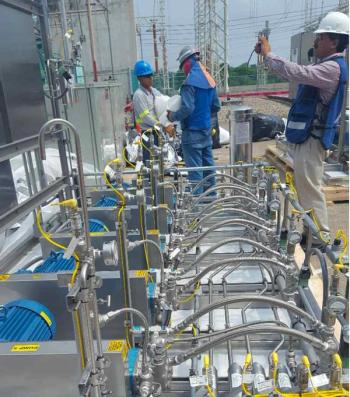
Rotordynamic Stability
OPERATIONAL MODAL ANALYSIS COULD BE A GAME CHANGER FOR THE TESTING AND DESIGN VERIFICATION OF ROTATING EQUIPMENT
Manufacturers produce rotating equipment to operate at speeds separated from natural frequencies (torsional and lateral), predicted at the design stage. Rotordynamic calculations, in line with API standards, are the current state-of-the-art tools for designing rotating equipment. Better verification measurements are needed, however, to further develop the tools, especially with regard to rotordynamic stability.
Operational Modal Analysis (OMA) is a technique for extraction of modal properties such as structural natural frequencies, damping and mode shapes. The technology has primarily been used for large structures, such as bridges and antennas, but new developments have expanded its use to rotating equipment. Aside from determining natural frequencies, the stability of rotors can be assessed during different operating conditions.
Figure 2: Compressor drive end proximity probe showing a sub-synchronous trace around 77 Hz appearED around 21:55 as the compressor speed increased. At 21:56, the compressor speed was 8500 rpm[/caption]
Figure 1: Power spectral density (green) and stability diagram (dots) from the centrifugal compressor when operating at approximately 11,000 rpm. The dots represent the stable points at which potential modes are as well as harmonics and non-synchronous components have been determined.[/caption]
OMA can be used on any machine equipped with shaft proximity probes. Vibration data from the proximity probes is the only required input data; knowledge of excitation is not needed. This provides logistical and cost advantages (cost-effective measurement results to design models) over magnetic bearing exciter testing. OMA is now being optimized for turbomachinery. It requires expert rotordynamic and machinery dynamics knowledge to interpret the results. This approach is a potential game changer as a method of assessing the rotordynamic stability on rotors in OEM design and testing and can be used in commissioning, troubleshooting, revamps and footprint measurements.
EMA vs. OMA
In order to determine the location of structural natural frequencies, the traditional approach is Experimental Modal Analysis (EMA). A structure is subjected to a known broadband force (for instance a hammer or a shaker), the response of the structure is measured and modal properties are extracted. While this approach works in certain situations, it does involve much complexity. For large buildings, for example, it is difficult to produce the force needed for excitation. In these situations, OMA is an established technology. It makes use of natural, ambient forces (wind, unbalance forces, surrounding machinery, and so forth) while output is measured with ordinary vibration probes. Vibration signals and modal parameters are recorded at realistic operational conditions.
The response is governed by the dynamic characteristics of the system and forces, which means that the output will be a mix of the two. The challenging aspect is to understand the behavior of the observed system and to filter out external forces to derive useful results. Moreover, the amplitude of the exciting forces will always be unknown; hence the modal mass of the system will not be determined using OMA.
For many rotating machines, modal parameters change during operation. Examples are hydrodynamic bearings, rubber couplings, gyroscopic- and centrifugal effects and anti-vibration mounts, which are speed- and temperature-dependent. For such units, traditional EMA with hammer and shaker impacts is not workable as it requires the shaft to be at stand-still and preferably the surrounding noise to be kept at a minimum.
At producing sites, this scenario is nearly impossible to attain. An alternative EMA methodology is to mount a magnetic bearing exciter on the shaft. Unlike the hammer and shaker technique, magnetic forces can be used to excite the rotor while it is still operating at realistic conditions.
A number of OEMs have taken part in projects that have reconciled test results of magnetic bearing exciters with model predictions. Due to the involvement of the OEMs, the modeling in these cases may be considered reasonably practicable. Unless the compressor is equipped with magnetic bearings, this approach requires a research and development environment mainly found at OEM sites or at research institutes and universities.
This rules out stability verification measurements on the bulk of machinery leaving OEM facilities; the end user is left to trust the screening criteria for rotordynamic calculations. For centrifugal compressors, API requires a logarithmic decrement of the first forward lateral mode to be above 0.1.
This number is based on experience and some operators have even chosen to increase the limit to 0.2, due to the inherent uncertainty that exists in stability calculations. OMA can be used to estimate the rotordynamic stability at Factory Acceptance Tests (FATs) using measurement data from the permanently installed shaft proximity probes.
The outcome of OMA is a power spectral density together with a stability diagram (Figure 1). The stability diagram establishes stable frequency points based on criteria determined by the analyst. Such criteria include variation in percentage of natural frequencies, damping and so on in the modal parameters extracted from a set of system orders.
These points are either natural frequencies or measured harmonics, such as the operating speed of the rotor (or adjacent machinery). OMA therefore requires expertise and experience in machinery dynamics to interpret the results and determine the natural frequencies.
Commissioning activities
A number of parties have applied OMA to large-scale rotating equipment. Below is an example of an OMA study from a 5.7 MW compressor, with an operating range of 7,540 rpm to 11,310 rpm, during offshore commissioning activities. The design was straight through with four impellers. It had two identical tilting pad journal bearings (5 shoes, load on pad), and the machine was equipped with oil seals as shaft end seals. Inlet pressure was at 1.8 BarA and discharged at 7.3 BarA. Normal vibration and process parameters were acquired independently over the course of about a week.
During commissioning, the compressor revealed traces of what was suggested to be rotordynamic instability (Figure 2). The compressor increased speed from approximately 2,280 rpm to 8,500 rpm and a subsynchronous component appeared at about 21:55 (Figure 1). When the compressor was operating at 8,500 rpm (after 21:56) the subsynchronous component was centered at about 77 Hz and was larger than the first order vibration component.
The sub-synchronous component appeared to have a relatively sudden appearance during the increase in operating speed, and coincidences of changes in other process parameters were investigated at the time of onset. The discharge pressure increased relatively rapidly during increasing speed as would be expected, but no abnormal features were noted. The subsynchronous frequency was close to both the OEM and third-party rotordynamic predictions of the first lateral bending mode.
OMA was applied to the data collected during commissioning. The input to OMA was the data recorded from the compressor’s four radial proximity probes. Figure 1 shows the result at 11,000 rpm. The running speed of the rotor was known from the key phasor measurement and can therefore be identified as not being a mode. However the distinction of the other non-synchronous components seen in Figure 1 as being modes or forced excitation sources is not possible from just a single stability diagram.
The sub-synchronous trace at 77 Hz at 8500 rpm (21:56) in Figure 2 was tracked with OMA and its deflection shape was reasonable for a first bending mode. However, when the speed increased to 11,000 rpm, the deflection shape ( Figure 4) showed a difference in the relative phase of the whirl between the DE and the NDE side. Further, the sub-synchronous frequency had increased from 77 Hz @ 8500 rpm to 92 Hz @ 11,000 rpm which is larger than would be expected for a first forward bending mode. It was therefore considered that this was a subsynchronous forced excitation component and not the first forward lateral mode.
It should be noted that the actual first bending mode of the same rotor was also identified using OMA which conformed with estimations from both OEM and thirdparty rotordynamic calculations.
Written by:
Dr. Eoin Peter Carden, a senior consultant at Register Marine. He undertakes troubleshooting and factory testing assignments in the marine and oil & gas industries. He attended University College Dublin, Ireland and was awarded his Ph.D. in 2003.
Staffan Lundholm, a senior consultant in the machinery dynamics team of Lloyd’s Register Consulting. His main tasks include project management, measurement campaigns, computational verification and prediction of rotating equipment within the oil & gas industry. He attended the Royal Institute of Technology, Sweden and was awarded his M.Sc. in 2007.
Dr. Niklas Sehlstedt, a department manager at Lloyd’s Register Consulting - Engineering Dynamics in Sweden. He holds a Ph.D. in M.E. from the Royal Institute of Technology in Stockholm. For more information: +46 8 445 21 00, info.consulting@lr.org, www.lr.org .
Newsletter
Power your knowledge with the latest in turbine technology, engineering advances, and energy solutions—subscribe to Turbomachinery International today.





